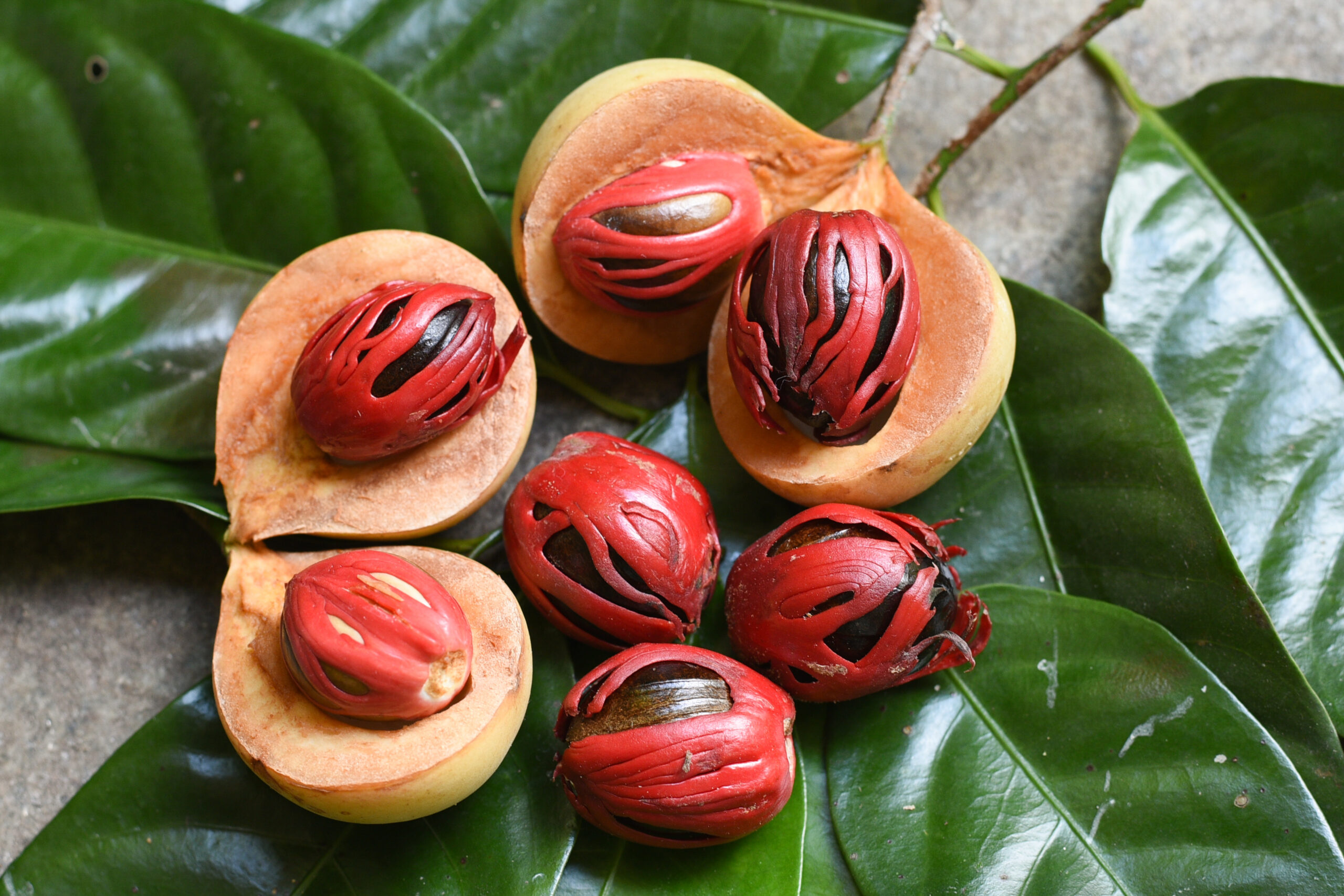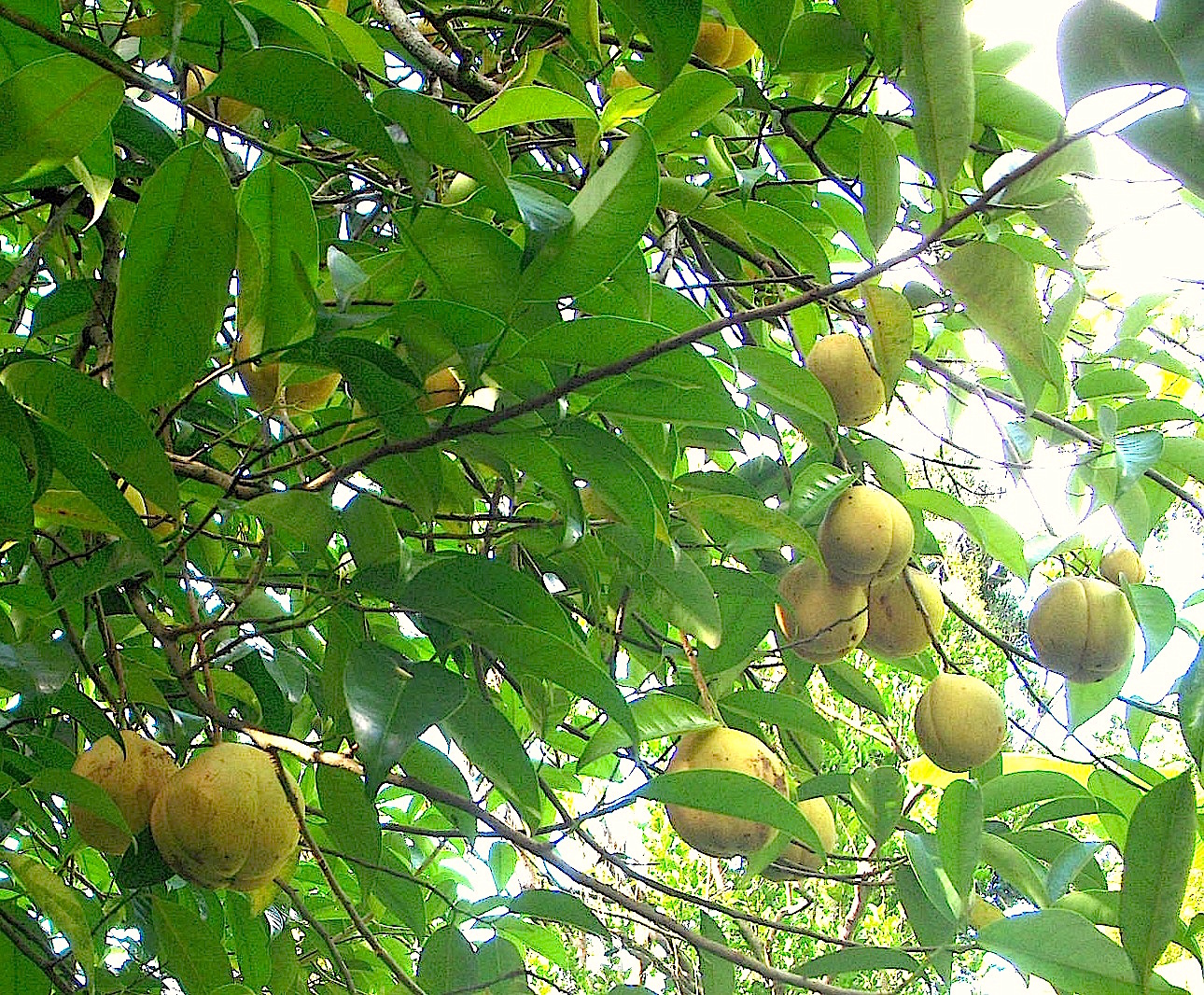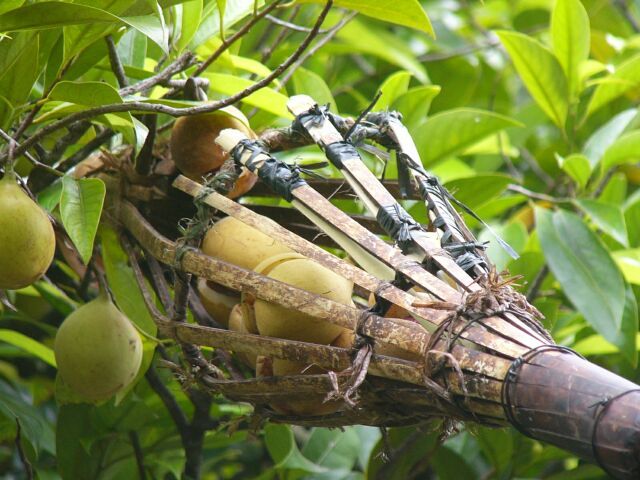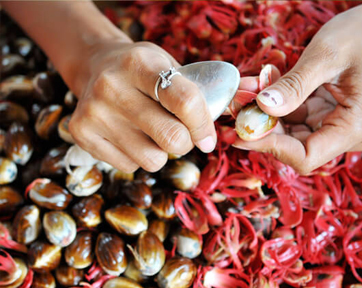The Nutmeg species of trees belongs to the Myristica genus. The botanical name of the commercially most significant species is Myristica fragrans, an evergreen tree indigenous to the Moluccas or “Spice Islands” of Indonesia. Nutmeg yields 2 different spices from the fruit, one is the actual inner kernel of the fruit and the other the red net like layer around it which consists of a leathery thin tissue called “Aril” or Mace situated between the kernel and the pulp. After sun-drying to develop its distinctive flavour, the outer fruit layer is removed and the pit or kernel separated. Mace is also often distilled separately from the Nutmeg kernel and yields a similar essential oil.

The evergreen Nutmeg tree can reach a height of about 20m and has dark green leaves. It is a dioecious plant which means that its white male and female blossoms appear on separate trees. They start carrying fruits after eight years bringing the highest yields at around 15 – 20 years of age.
Both Nutmeg and Mace are used in culinary recipes worldwide for all kinds of dishes and baked goods. Mace is said to have a finer aroma than Nutmeg. Both spices are of many praised benefits for the digestive system. And both spices are usually sold as powders.
Nutmeg essential oil
The essential oil is obtained by steam distillation of the ground Nutmeg kernel. It can contain about 10% of essential oil which is probably one of the highest amounts of yield of spice essential oils. And it is highly aromatic – one of the reasons why it is in strong demand in the perfumery and pharma industry, for instance as a component in cough syrups or toothpastes. It is also used for beverages and syrups. Nutmeg provides also a fat oil, known under the name Nutmeg butter because of its butter-like consistency. The oil has a pale-yellow colour with smells and tastes of Nutmeg being very aromatic and intense in flavour. It is recommended to use it in small amounts only to not irritate the digestive system.

In Europe the healing properties of Nutmeg seem to have been long forgotten, whereas in Asia it is very popular as a remedy against weakness of liver and gall bladder for example, and also in case of sleeplessness. Already Hildegard von Bingen praised Nutmeg’s calming and heart strengthening effect and its increase of mental focus, a reason why she used Nutmeg in her recipe of ‘nerve cookies’ which contain also Cinnamon and Clove. Ayurvedic medicine, too, appreciates the soothing effects of Nutmeg as a spice due to its balancing effect on the Samana Vata dosha in the human body which is linked to the digestive system. Ayurveda also mentions Nutmeg as remedy to help against headaches, fever, and against bad breath. Nutmeg has also positive influences on rheumatic diseases and skin problems. According to historical reports, already the Byzantine doctor Simon Seth wrote that the fruit of Nutmeg is beneficial for the stomach, the liver and the heart if used moderately. In Arabian writings one can find Nutmeg spice mentioned for digestive problems and as an aphrodisiac too.
A chemical analysis of the oil shows the main ingredients consisting of Sabinene or Camphene (50%) and d-Pinene (20%), less than 10% are Dipentene, d-Linanool, d-Borneol, i-terpineol, Geraniol, Myristcin, Sagrole, Eugenol, iso-Eugnol.
Nutmeg oil blends well with oils of Orange, Oakmoss, Bay Laurel, Peru balsam, Clary Sage, Rosemary, Lime, Geranium, Mandarin, Petitgrain and Coriander.
A bit on the History
Looking at the spice from the historical viewpoint, probably Nutmeg came to Europe by the Arabs via the spice trails with Venice first being the major “customer” and trader. Nutmeg became quickly very popular and expensive. In the sixteenth century it was called the ‘gold of India’. The British, Spanish, Portuguese and Dutch were fighting intensely with one another on the Nutmeg trade, and finally the Dutch received the monopoly by exchanging with the British the island of Manhattan against the small island of Run in the East-Indian Archipelago. During that time when the Dutch had the supremacy over the Nutmeg trade, they felled the trees on other islands in order to enforce their own monopoly – to the great harm of the indigenous population who were relying on Nutmeg also as medicine. During the second half of the sixteenth century Nutmeg was said to be the only effective medicine against the plague, an effect supported by the fact that it has clear antibacterial properties. Consequently, the prices increased immensely. During the Napoleonic wars the English managed to transplant some Nutmeg trees to their own colonial holdings, especially to Zanzibar and Grenada. The national flag of Grenada shows a split open Nutmeg fruit. Indonesia and Grenada today are the main producers followed by India, Malaysia, Papua New Guinea, Sri Lanka and some other Caribbean Islands. The main importers are the European Community, the United States and Japan.
In tropical areas Nutmeg can be infested by insects or mould with some of them producing the carcinogen aflatoxins. Sometimes such infected products are put on the market illegally in the producing countries. But the nuts can be distilled into the essential oil without danger for the customers. The essential oil often is less expensive than the corresponding amount of highly qualitative Nutmegs.

More on properties and recipes
Nutmeg, even as a spice, can be considered as a drug if taken in excess. 1/2 to 1 Nutmeg can be enough to create psychic effects and – if overdosed – can lead to hypersensitivity, nausea etc. This is mainly caused by the presence of compounds called phenylpropanoids: Nutmeg contains myristicin, elemicin, safrol, and eugenol…

Nutmeg is often mentioned to help against seizures, convulsions, and epilepsy. This effect is totally dose dependent:
“Nutmeg (Myristica fragrans, MF) possesses anticonvulsant activity against PTZ, MES and lithium-pilocarpine induced seizures and lower doses were more effective in inhibiting seizures…
In various animal models of seizures used in study, the anticonvulsant activity of MF decreased with increasing doses. In status epilepticus, the animals receiving MF in a dose of 10 mg/kg reduced the severity of seizures at much earlier time. These observations support the biphasic effect of MF (Nutmeg) on the central nervous system.
https://www.ncbi.nlm.nih.gov/pmc/articles/PMC4724851/

Main properties summarized
• analgesic and pain-relieving on the muscles
• digestive stimulant
• emmenagogue – regulates menstruation, promotes childbirth
• antiseptic and anti-parasitic
• anti-rheumatic
• aphrodisiac
• nervous toner and tranquilizer (good also for insomnia)
• good for weak liver and gall bladder

Some formulas
Digestive problems (Nelly Grosjean)
• Caraway: 9ml
• Nutmeg: 6ml
• Coriander: 4ml
• Cumin: 1ml
Dilute the mixture in a little vegetable oil and apply 5 drops of the mixture in frictions on the stomach and abdomen after a meal.
Circulatory disorder – Raynaud’s disease (N. Purchon)
• Rosemary: 20 drops
• Black pepper: 10 drops
• Nutmeg: 10 drops
• Geranium: 5 drops
in sweet Almond oil: 2 tablespoons
Use as a massage oil on the hands and feet or in a bath.
Conclusion
All in all, we can say that in Nutmeg and it essential oil we find another example of a powerful and versatile combination of compounds, effects, energies which are more than enough to trigger our admiration and curiosity for Nature’s creativity in terms of time-tested medicinal plant evolution.
Nutmeg is a spice for us, yes, but what does it mean? Is a spice just a “spice” or may it be that a spice has something to do with “spicing up” our existence, our own creativity, our own energies? We have to ask ourselves: Why was the Western culture so fascinated when the “spice trade” with the South-East Asian countries started with Pepper, Clove, Nutmeg etc.? It is true: there was the hot Sun lacking in mot of the Western countries – and the “element” of Sun has a lot to do with the spice plant group. And this hot Sun was now made available and “imported” thanks to these spices – which dramatically changed also the Wester cuisine … and maybe the cultural habits and behaviours of many people too.
Another thought: Nutmeg’s connection via the phenylpropanoids with the akashic, ethereal, or astral planes gives us something to reflect. When a plant has strong ethereal compounds, Rudolf Steiner already remarked, it tries to connect through this with a higher evolutionary order. In the case of the vegetal kingdom it tries to connect particularly first with the animal kingdom.
And in the case of us humans? We can deduce that even a medicine, mainly just used for the digestive tract, can be more than “just that”. An inner intuitive logic pulls us towards looking at that area where true healing has its roots – namely the subtle layers of our psycho-physiological build-up. Our guts are more than “just guts”, we know this today. From “guts to brain” goes the song 🙂 – or does it go “from brain to guts, back and forth” ? :):) Anyhow, anyway, we have to dance to the music of the subtle and the gross, and often, what seems gross hides the subtle behind…
Nutmeg, a pleasantly warming and invigorating spice which triggers that inner fire, that inner light in us, which can help us in some mysterious ways to reconnect or straighten certain “loosened threads” within the network of our “body-mind”. Does it not sound bit like that, the botanical name of Nutmeg “Myristica fragrans”? I would nearly say “Mystica fragrans”!! :):)
